
Food in art

Food has been a fascination of artists since the dawn of time, whether as a model or as a constituent material of a work of art. As a vital need and a place of socio-cultural connection, our way of eating inspires artists. But what place does food have in art? And how has it evolved over time? Artsper offers you an overview of an art that nourishes even more than usual!
Food in art: in search of an appetizing realism
Timeless and effective, still life paintings that pay tribute to food are not new. The Greek painter Piraïkos represented very realistic food in his paintings in the 3rd century B.C. Then, in the 16th century, the prohibition of biblical scenes by the Reformation placed the still life at the center of art. It was Caravaggio, by taking a basket of fruit as his only subject, who established still life as a pictorial genre. It opened the doors to a flourishing productivity: Cézanne, Matisse, Moillon, Van Gogh, Chardin, Manet, Bagatskaya all followed suit. The list of artists who have invested the culinary still life is impressive.
And this aesthetic idealization of food is still relevant today! Just take a look at Instagram to see that. Foodporn is pretty popular, and artists keep inventing new ways of giving taste to their images. No matter the era or culture, art’s obsession with food never seems to be satiated!

Pop artists: ode to and critique of industrial food
The love affair between art and food continued into the 1960s. But as food has changed its look through industrialization, art also approaches its representation differently. Glorification or denunciation of overproduction? Limits are sometimes good. We see pop art highlighting food of everyday life: Coca-Cola bottles, canned food, fast food, etc. It’s a moment captured in American consumer society, in its most attractive features, as well as in its darkest facets. Andy Warhol initiated this movement, followed by many other artists, such as Duane Hanson with his hyperrealist sculptures or Beth Galton with her deliciously cut-in-half dishes.

Food in art: denouncing overabundance and waste
An almost diametrically opposed movement is emerging which aims to denounce food waste and to advocate recycling. This is the case of artists like Alex Yudzon, who produced The Book of Healthy and Tasty Food. This series of photographs invites us to meditate on our relationship with food and the excesses that accompany it. Another artist, another concept. In her series Ugly Produce is Beautiful, Sarah Philips honors vegetables that are wasted because they are considered ugly. The same goes for the artist Mr BMX, who links art, food and solidarity, by hanging a shopping cart on the wall of a supermarket. Why do this? So that customers can leave food for people in need.

The Undrinkable Can: a satirical art project
“The Undrinkable Can” is a 360 satirical art project with the aim of shedding light on the environmental catastrophe and concerning health implications attributed to the Coca-Cola Company. This innovative concept revolves around a limited edition art piece: bespoke cans meticulously crafted, each containing Coca-Cola and permanently sealed, rendering them utterly undrinkable. Accompanying each can is its uniquely numbered display box, along with precisely 39g of sugar, mirroring the standard content found in a typical Coke can.
The driving force behind this project stems from a series of alarming events. In the early 2000s, Vicente Fox, former CEO of Coca-Cola Mexico, assumed the presidency of the country. Subsequently, Coca-Cola swiftly secured a significant portion of major water concessions across various regions, extracting millions of liters of water daily. This exploitation has precipitated severe water scarcity and dire health repercussions throughout the nation.

The pricing strategy is as intriguing as the concept itself: a “first come, first served” mechanism determines the cost of each can. The first can was priced at $1, followed by sequential increases with each subsequent purchase – $2 for the second, and so forth. All profits generated from “The Undrinkable Can” within a month are earmarked for investment in a short position against Coca-Cola’s stock on Nasdaq.
This artpiece was showcased at the esteemed Zona Maco art fair, recognized as Latin America’s Premier Art Fair, “The Undrinkable Can” earned the distinction of the “most curious Art Piece of the fair.”
Food, an enhancer of socio-cultural issues
Contemporary art is also seeing the emergence of new questions about food, more focused on its social and cultural dimension. This is the case of Daniel Spoerri, at the origin of the “Eat art” movement. Among his various works, he organizes several meal-performances open to the public. The guests are separated in two: on one side, the rich, on the other, the poor. Why? To question the socio-cultural value of food, while enjoying a moment of exchange. The artist has also created many “trap paintings“, immortalizing the remains of meals.
In the series of meal-performances, we also find the work of Vanessa Beecroft, focused on the obsessive relationship to food. Or the collaboration of Trapier Duporté and Luc Avargues, which questions what’s right among culinary codes and the conviviality. And how can we not mention the Disgusting Food Museum? A museum that showcases the most disgusting food in the world! Beyond the visual experience, this initiative questions the close link between culture and food, life and sustenance.

The culmination of many paradoxes
If food in art holds this golden place, it is not by chance. It is at the center of many paradoxes. The waste and the necessity, the social and the intimate, the respect of nature amid industrialization, daily life and exceptional moments. It translates as well into a tasty present or a consumed past. Food art is a beautiful way to honor life and conviviality, while also questioning social and cultural determinism.

About Artsper
Founded in 2013, Artsper is an online marketplace for contemporary art. Partnering with 1,800 professional art galleries around the world, it makes discovering and acquiring art accessible to all.
Learn more












